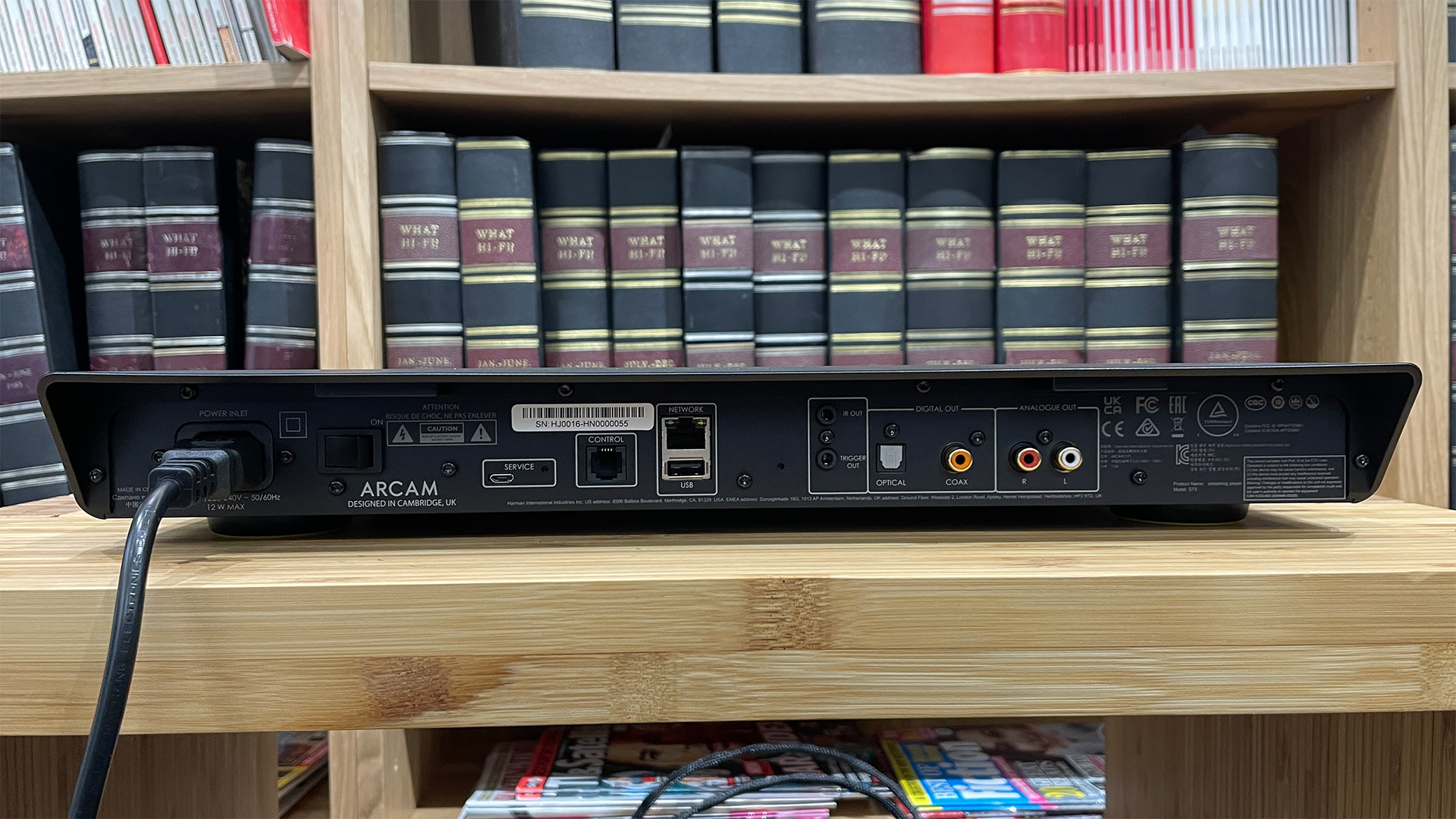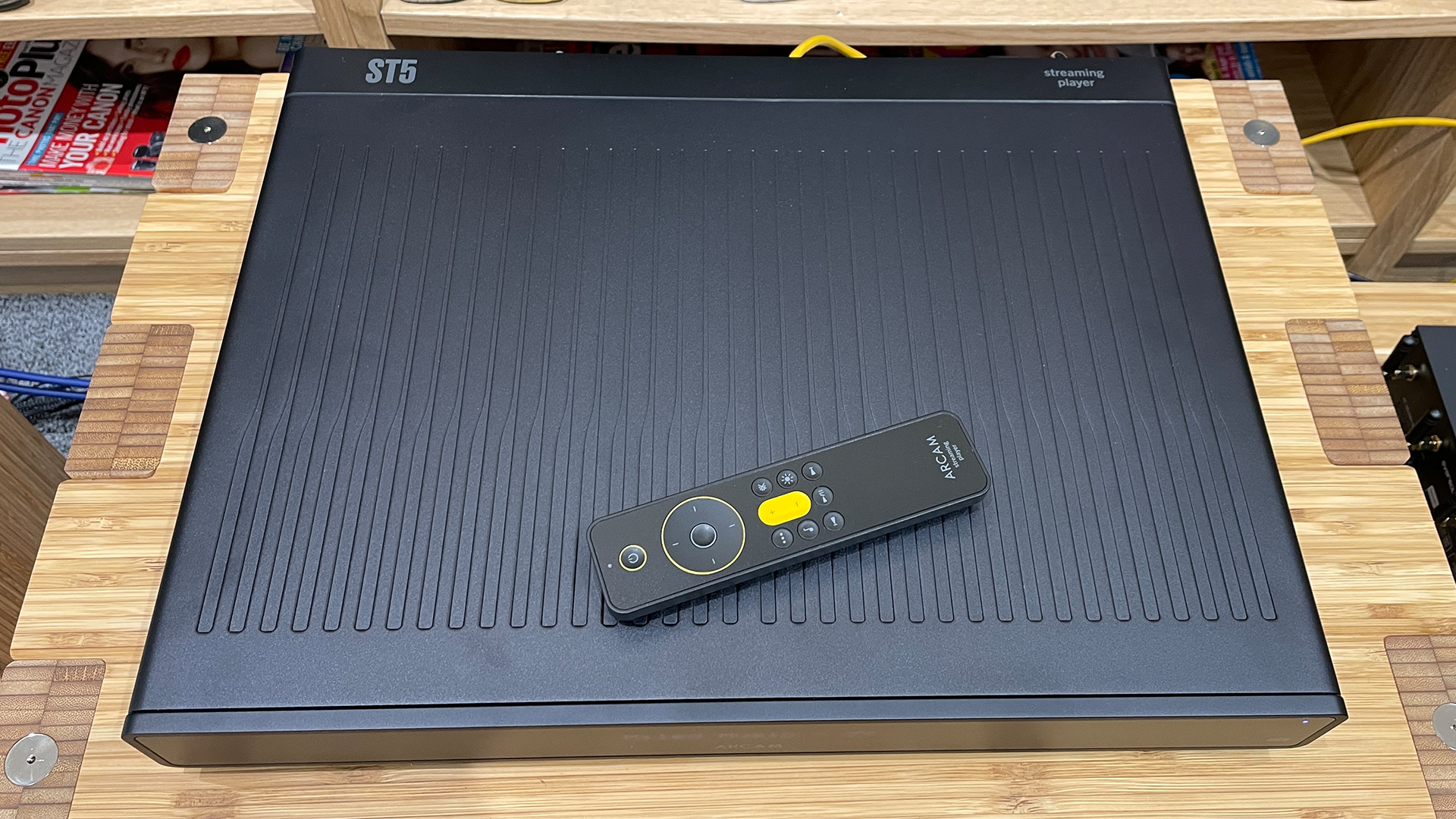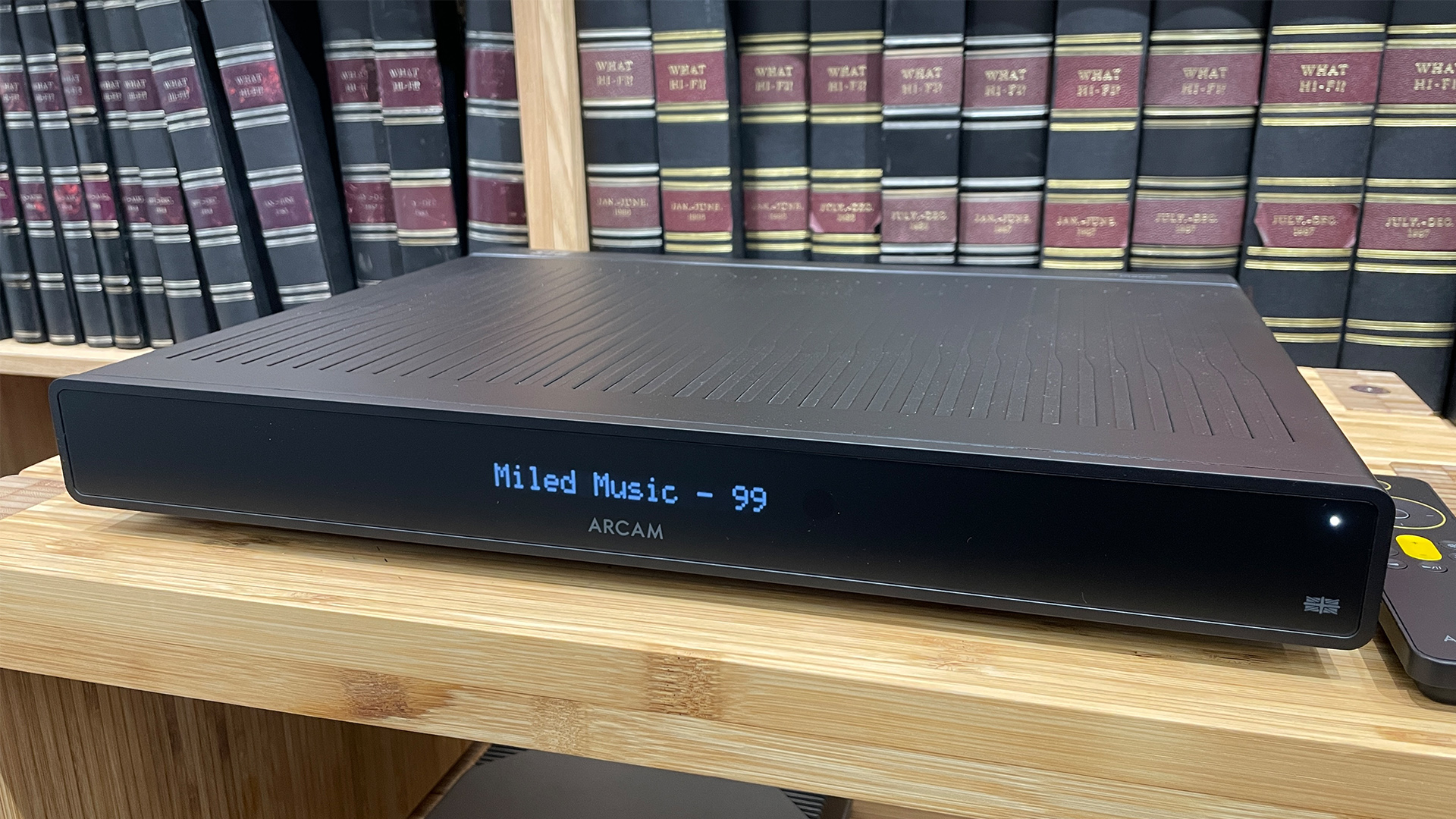What Hi-Fi? Verdict
Arcam’s ST5 is a decent, solid performer that’s pleasant to listen to, but the user experience leaves much to be desired
Pros
- +
Smooth, easy-going presentation
- +
Clean, detailed sound
- +
Particularly appealing with voices
- +
All essential streaming options included
Cons
- -
Class leaders reveal greater detail, better dynamic subtlety and rhythmic agility
- -
Rival streamers offer a more seamless, complete user experience
Why you can trust What Hi-Fi?
Arcam’s new Radia range of hi-fi separates has already gained acclaim, with the A5 and A15 amplifiers and CD5 CD player all receiving five-star reviews and 2023 What Hi-Fi? Awards wins. Now it’s the turn of the brand’s new music streamer – the Arcam ST5 – to be put on the review chopping block.
Priced at £799, the ST5 goes up against the formidable Cambridge Audio CXN (V2), which has been our favourite network audio player at this price for six years running. There’s also a new crop of streamers from brands such as WiiM and Eversolo, that have reared their heads and shown just how slick a modern network audio player can be – while still delivering enjoyable sound. Can Arcam’s string of successes continue with its new network streamer?
Build & design
The minimal, all-black design we’ve encountered across all products in Arcam’s new Radia line is repeated here. The ST5 is well made, with the anodised aluminium casing offering a sturdy build and overall neat look. There are no vents on this model and it’s a slimmer, more anonymous design than the amplifiers and CD player in the same range that we’ve reviewed.
There are no buttons on the front either, with just a simple one-line text display behind the same frosted glass front as its siblings. We find that this means the text, while large and easy to read from a distance, is a tad fuzzy compared with the crisp sharpness of the full-colour displays on the Cambridge CXN (V2), the Eversolo DMP-A6 and even Arcam’s older ST60, for instance. Arcam said it has focused its efforts entirely on audio performance with the ST5, so certain extra flourishes – such as an OLED display, which uses up additional microprocessor power – have been omitted in the new model.
While the new ST5 doesn’t directly replace the five-star (and soon-to-be outgoing) Award-winning Arcam ST60 streamer (which launched at a pricier £1199 / $1500 / AU2495), it is an evolved model. The ST5 has a more efficient single microprocessor (compared with the ST60’s two) as it no longer needs to drive that OLED display. It also has upgraded components in specific areas in a bid to improve sound quality alongside an improved power supply with higher voltage rails.

Sources UPnP, AirPlay 2, Chromecast built-in, Internet radio, Spotify Connect, Tidal Connect, Amazon Music, Qobuz
Network Wi-fi, internet
Inputs USB type-A
Outputs Optical, coaxial, line level RCA
Headphone output? No
Max file resolution 24-bit/192kHz, DSD128
Dimensions (hwd) 5.7 x 43.1 x 34.4cm
Weight 3.5kg
You get a small remote control with the ST5, which is compact, solidly made and works well enough with the streamer. Some of the ST5’s features and commands can only be accessed by the on-unit menu itself, such as selecting the digital filters, the output types (Analogue, Digi Core and Bitstream) and the type of volume output (Fixed, Variable, External). Arcam recommends that you select the External output if you’re using the ST5 with a control link to a matching Arcam A5 or A15 amp (the specific connector cable is supplied in the box). This method passes all volume control duties over to the amplifier and, more crucially, allows the amp to respond to commands from the ST5 remote and app. It is claimed to maximise the signal-to-noise ratio and dynamic range when the two Arcams are paired together, too. As for the digital output types, Digi Core is the one to use if you want the ST5 to handle all MQA decoding, while the Bitstream mode leaves the MQA decoding to the external DAC.
You can also save six of your favourite internet radio stations as presets (initially saved through the accompanying app – more on that later) and access them quickly using the remote’s basic controls, which is a nice touch. Accessing the sub-menus on the limited display does take a while to get used to, and while it isn’t necessary to have a full display on a streamer (just look at Cambridge MXN10 or Bluesound Node 2021), we think it would have made it just a bit easier to navigate the sub-menus on this player.
The latest hi-fi, home cinema and tech news, reviews, buying advice and deals, direct to your inbox.
Features

The Arcam ST5 is well-furnished when it comes to its main job as a network streamer. You can connect the ST5 to your home network via wi-fi or Ethernet, and you’ll be able to play music files stored on the same network (on a connected NAS device, for instance) thanks to UPnP streaming. Apple AirPlay 2 and Chromecast built-in are provided for easy streaming from various smart devices, and there’s built-in support for Tidal Connect and Spotify Connect too. You can play songs from these music services’ native apps directly, rather than through the new Arcam Radia app.
The Arcam Radia app is simple; like the ST5 streamer itself, it sticks to the basic operations you’ll need in daily use. Set up is swift, and you can access global internet radio stations, podcasts, browse your digital music library stored on the UPnP network and access any files attached to the ST5’s USB Type-A input by using the app. The ST5 is also Roon Ready certified, and you can employ firmware updates through the app, which is always useful.
There’s no sign of the Tidal and Spotify apps within the Arcam’s control app, even to note that the ST5 supports the Connect versions of these services – which leaves the main source page feeling rather empty. Qobuz and Amazon Music Unlimited are supported through the Arcam app, to enable playback of hi-res 24-bit/192kHz files from these services (as they don’t have the Connect models yet).
We find the experience of using the ST5 rather fragmented: unlike the Cambridge, Eversolo and WiiM apps, there isn’t a single place from which you can access and control everything. We wish, for instance, that we could access all of the ST5’s menu options from within the app, rather than scrolling through the on-unit menu with the remote. It would make things so much simpler and easier, especially as we don’t find it intuitive to use the remote with the ST5’s restricted display.

The apps we’ve used with the Cambridge, Eversolo and WiiM streamers offer a far more intuitive and streamlined experience, with all the features and options laid out in an engaging, well-designed, one-stop interface. There’s no confusion about where to go; if you’ll be juggling multiple streaming sources, it makes a huge difference when the manufacturer makes it easy for you in daily use. We found using the Arcam ST5 overall quite frustrating and curiously incomplete as a result – it certainly does have plenty of features, but they’re squirrelled away or accessed through either the remote or app (but not both) that makes it just not as seamless to use as its rivals. We also had some instances of dropouts during playback – through the internet radio, particularly – which we didn’t experience when using the Cambridge and Eversolo streamers during the same testing period.
In terms of physical connections, there is one optical and one coaxial output, and a pair of line-level outputs. There’s no Bluetooth, which seems like a surprising omission to us, especially considering that the Cambridge CXN (V2) and the much cheaper Cambridge MXN10 and Bluesound Node (2021) provide it. Bluetooth may not be the best-sounding method of streaming, but it’s a convenient method of playing music wirelessly that doesn’t require a wi-fi connection.
Internally, the streamer uses an ESS ES9018 DAC chip – the very same one used in the A5, A15 amps and CD5 CD player – with additional time jitter elimination technology. Hi-res audio is supported up to 24-bit/192kHz and DSD128, along with MQA support. While the majority of hi-res files available (such as those in our reference system’s expansive digital library) fall within these parameters, it’s worth noting once again that the Cambridge Audio streamers (CXN V2 and MXN10) and Eversolo DMP-A6 all support up to 32-bit and DSD512 formats. So if you’re a digital music aficionado with the highest variety of high-res music files in your library, the Arcam streamer’s limits might be, well, limiting.
Sound

We tested the Arcam ST5 over the course of multiple weeks, plugged into our reference system of the PMC Cor stereo amplifier and Epos ES14N speakers, as well as more price-compatible kit such as the Arcam A5 amp (using the control link connection) and KEF LS50 Meta and PMC Prodigy 5 speakers. We streamed songs in a variety of ways, including Tidal Connect, internet radio, from our smartphone using AirPlay 2, and playing hi-res files stored on our Naim Uniti Core server.
With this streamer, we hear the same genial, composed and full-sounding presentation we liked so much in the A5 and CD5. The ST5 streamer has an ease and friendliness to the way it approaches music played through it, and is capable enough to show the differences in file qualities. Feed it higher quality digital files and the ST5 will shine a bit brighter, delivering tunes with richer detail accordingly.
We cycle through Major Lazer’s Pon De Floor, Hans Zimmer’s Inception soundtrack and Agnes Obel’s The Cursed, and find the Arcam delivers clean highs that never sound harsh or bright, while the low frequencies are delivered with enough solidity, but not quite plummeting to the deep, agile depths we’ve heard in rival products.
The ST5’s main talent lies with voices. There’s an immediacy and sweetness to the way it handles vocals, with a natural warmth that, whether it’s Kate Bush or Corey Taylor, Nina Simone or Bruce Springsteen, is appealing to listen to. The ST5 isn’t the most neutral of streamers as it’s on the smoother side, but that easy-going nature and ability to deliver each track in a way that won’t ever offend or distract can have its charm.
Nothing sticks out unduly, and it’s a sonic character that doesn’t attract too much attention to itself. This approach may not please all, however, especially if you want a more involving, thrilling listen.
We compared the ST5 against its natural rival, the Cambridge CXN (V2), and we find the latter is just that bit more dynamic, more agile, and unearths a greater degree of texture and depth in recordings. Through the CXN, the piano notes on Erik Satie’s Gnossienne No.1 piece hit with authority and are more expressive, making the different pressures placed on each key more apparent. The plucking of strings in Obel’s The Curse is more emphatic and accurate, and it goes quieter, too: the quiet/loud/quiet upheavals have more drama.
While the ST5 sounds clean and solid when playing Run The Jewels’ Close Your Eyes (And Count To…), it’s the Cambridge that adds in those missing elements of punch, attack and attitude that are inherent in the song. We also find that the Arcam player tends to push all elements in a track – instruments and vocals – forward, as if they’re all on the same plane. The Cambridge offers a more three-dimensional soundstage for songs to breathe, and you can more accurately pinpoint exactly where every element is in the mix. Additionally, with the ST5 positioned as a more evolved ST60 (which is a former Award-winner), we listen to both models during our review. We find that the ST60 sounds better to our ears: the bass may be richer and fuller, but it delivers more subtle detail, and overall is more interesting to listen to than the ST5.
Verdict

The Arcam ST5 has all the building blocks needed for a good, if not great, network streamer, but it’s trailing behind when it comes to the feature set and user-friendliness expected by today’s customers, especially at this price point. There’s a lot to be said for keeping things simple in a product, but while this approach may work with amplifiers and CD players, it doesn’t quite translate with more complex products like streamers, which have to juggle multiple streaming solutions and sources – especially when it’s the end user that needs to be able to control it all. The ST5 just doesn’t feel like a fully developed product.
It would be a different matter if the ST5’s sound quality was so good that we could perhaps forgive some of the frustrating issues around its usability, but we don’t find its performance to be on the same level as the rest of its excellent five-star siblings. As such, the Arcam ST5’s usability issues become its weakest link, and there are far more entertaining and user-friendly rivals at this price, such as the Cambridge Audio CXN (V2), that we can more wholeheartedly recommend instead.
SCORES
- Sound 4
- Features 3
- Build 4
MORE:
Read our review of the Cambridge Audio CXN (V2)
Also consider the Eversolo DMP-A6
Best music streamers: upgrade to a wireless system
What Hi-Fi?, founded in 1976, is the world's leading independent guide to buying and owning hi-fi and home entertainment products. Our comprehensive tests help you buy the very best for your money, with our advice sections giving you step-by-step information on how to get even more from your music and movies. Everything is tested by our dedicated team of in-house reviewers in our custom-built test rooms in London, Reading and Bath. Our coveted five-star rating and Awards are recognised all over the world as the ultimate seal of approval, so you can buy with absolute confidence.


